ULA chronicles the rise of Vulcan rocket in new employee-drawn comic book
'A comic book, that's how you tell a superhero's origin story, right?'
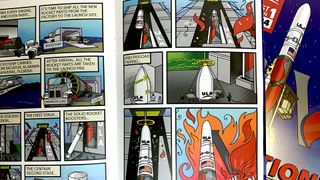
Vulcan, United Launch Alliance's (ULA) new heavy-lift rocket, was not the result of having to flee an exploding planet, being exposed to gamma rays or even surviving the bite of a radioactive spider, but it does have an origin story compelling enough to warrant it having its own comic book.
Or so struck Cory Wood, ULA's senior graphic designer, who led the creation of "Ignition! The Origin Story of the Vulcan Centaur Rocket," the first (and perhaps only) issue of the aerospace company's new celebratory graphic novel.
Related: ULA's 1st Vulcan rocket launch looks spectacular in these photos
"I'm sort of a big nerd. And so in thinking about it, how do you tell the story of something that has taken this much time, this much effort and all of these people's intelligence and background to make it successful?" said Wood in an interview with collectSPACE. "It just felt like that superhero moment that needed its origin story told. And a comic book, that's how you tell a superhero's origin story, right?"
ULA's CEO Tory Bruno, who is depicted in "Ignition!", revealed the comic book's existence on social media on Friday (April 5), three days before its physical debut at Space Foundation's Space Symposium in Colorado Springs. Attendees were able to pick up a copy while ULA finalizes its plans for making the Vulcan Centaur comic book available to the general public. (A digital version can be found on ULA's website.)
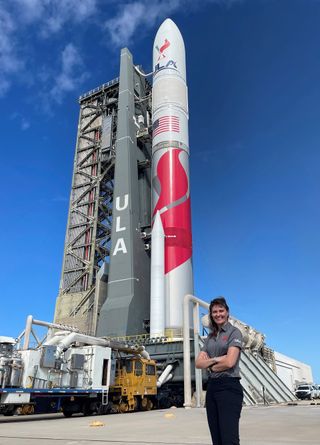
Readers who are unfamiliar with the rocket's history will discover that the Vulcan got its start in 2014, soon after Bruno "with his trusty steed Indigo" was brought in to lead ULA.
"Indigo, we need to get home to meet with the engineers. Our country needs us," declares Bruno in one of the opening panels of the comic book.
Indigo features throughout "Ignition" — as the "rocket horse" did in real life, appearing to his fans' delight on Bruno's social media feed. The comic book also serves as a fitting memorial. "We wish him well as he explores pastures and his engineering expertise on horsepower, from this world and the next. He is missed by us all," reads a tribute on the last page.
Related: Vulcan rocket launches private moon lander, human remains in 1st flight
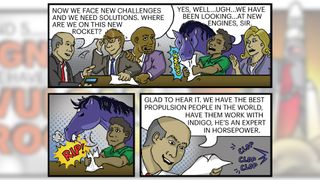
"We wanted everybody to have a moment in this book where reading it you realize, 'Ah, I remember this,' or 'Ah, I'm a part of this,'" said Wood. "So whether you are an employee and you got a big chuckle out of Tory with the t-shirt cannon or you follow us on social media and you remember Indigo as a part of the story, we wanted to have these little tidbits that different people would identify with."
"So it was easy to take all of Tory's huge, grandiose, fabulous personality and use that social cowboy aspect so that our social followers would get a big kick out of it," said Wood. "It only seemed natural then for Indigo to become a character, too, as we began to step down that road."
Central to "Ignition" is the story of Vulcan, from how it was designed, named, built, assembled, tested and ultimately, launched. That tale includes the ULA rockets that preceded it — the Atlas and Delta — and why the capabilities built into the Vulcan's design are needed by the company's national security, government and commercial clients.
Get the Space.com Newsletter
Breaking space news, the latest updates on rocket launches, skywatching events and more!
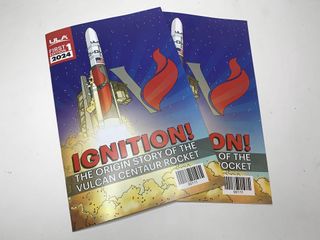
Along the way, the message becomes even clearer. This is Vulcan's origin story, but the rocket is not the only superhero.
"It is really about all of the engineers and all of the effort and time that all of these different heroes throughout our company have pulled together to create such a wonderful vehicle that's coming forth and maybe defining our future. So when we talk about the story or heroes in the story, it's Vulcan, but it's also all of the people standing behind Vulcan to help create her," Wood said.
"Ignition" is Wood's first comic book and she strove to make it a love letter to the art form. She began with pencil sketches, progressed to ink and paint drawings and then scanned those pages to finish the book on the computer. She was also sure to include details all comic book fans would appreciate, including a page of ads (here hawking different aspects of ULA's business rather than 3D glasses and cheap magic tricks) and an all-important detail on the cover.
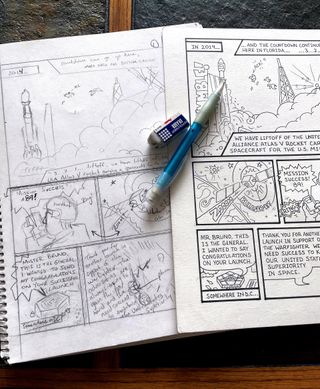
"We really don't want the comic book to be sold at stores but at the same time, as a kid picking up a comic, you look for the first print, first edition," said Wood. "So the barcode '00111' is the comic you want out of a series. The '001' is a reference that this is the first print of the series. Then the next '1' means it is the first cover art and the last '1' is the first printing of that exact comic."
Which begs the question: will there be an issue '00211'?
"I don't know," said Wood. "Volume One entails our history as a company and as a team, so I think Volume Two has yet to be written. It is still in front of us. But I'm excited to find out and walk with the rest of this team as we figure out where this goes. And maybe, someday, we'll get to tell that story, too."
Follow collectSPACE.com on Facebook and on Twitter at @collectSPACE. Copyright 2024 collectSPACE.com. All rights reserved.
Join our Space Forums to keep talking space on the latest missions, night sky and more! And if you have a news tip, correction or comment, let us know at: community@space.com.

Robert Pearlman is a space historian, journalist and the founder and editor of collectSPACE.com, an online publication and community devoted to space history with a particular focus on how and where space exploration intersects with pop culture. Pearlman is also a contributing writer for Space.com and co-author of "Space Stations: The Art, Science, and Reality of Working in Space” published by Smithsonian Books in 2018. He previously developed online content for the National Space Society and Apollo 11 moonwalker Buzz Aldrin, helped establish the space tourism company Space Adventures and currently serves on the History Committee of the American Astronautical Society, the advisory committee for The Mars Generation and leadership board of For All Moonkind. In 2009, he was inducted into the U.S. Space Camp Hall of Fame in Huntsville, Alabama. In 2021, he was honored by the American Astronautical Society with the Ordway Award for Sustained Excellence in Spaceflight History.

